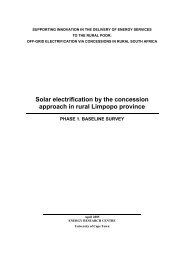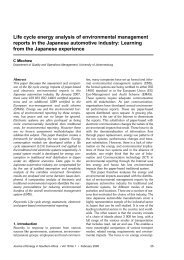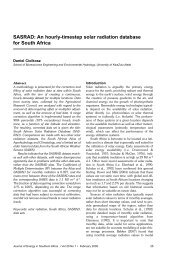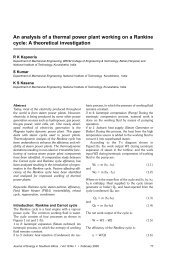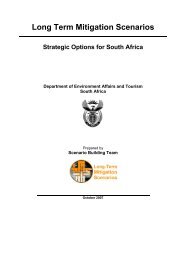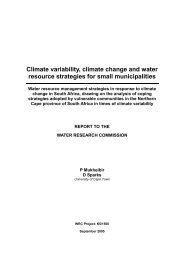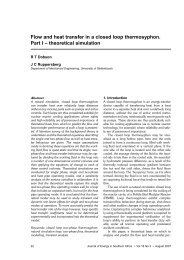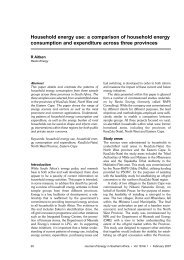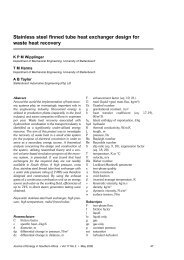Heat recovery in the textile dyeing and finishing industry ... - erc
Heat recovery in the textile dyeing and finishing industry ... - erc
Heat recovery in the textile dyeing and finishing industry ... - erc
You also want an ePaper? Increase the reach of your titles
YUMPU automatically turns print PDFs into web optimized ePapers that Google loves.
Figure 4: Coupl<strong>in</strong>g heat <strong>recovery</strong> <strong>and</strong> environmental pollution control<br />
<strong>in</strong> <strong>the</strong> literature by Reay (1977) <strong>and</strong> Applegate<br />
(1983). The properties of heat exchangers for hot<br />
air exhaust heat <strong>recovery</strong> <strong>in</strong> <strong>the</strong> <strong>textile</strong> <strong>in</strong>dustry are<br />
summarized <strong>in</strong> Table 1.<br />
4. Alternative developments<br />
Apart from <strong>the</strong> <strong>in</strong>creas<strong>in</strong>g use of Information<br />
Technology, steam utilization is also characterised<br />
more <strong>and</strong> more by <strong>the</strong> use of gas as combustible<br />
<strong>and</strong> <strong>the</strong> decentralisation of steam production.<br />
However, decentralised steam supply needs high<br />
capital-<strong>in</strong>tensive <strong>in</strong>vestment <strong>and</strong> <strong>the</strong> payback period<br />
is generally more than 2 years (ITF, 1991; EEO,<br />
1991; EEO, 1992). The potential to lower energy<br />
consumption by more than 20%, <strong>the</strong> reduction <strong>in</strong><br />
process time, <strong>the</strong> absence of steam starvation <strong>and</strong><br />
<strong>the</strong> avoidance of production bottlenecks are strong<br />
reasons for shift<strong>in</strong>g to decentralised generation.<br />
Gas is practical for use <strong>in</strong> direct water heaters<br />
<strong>and</strong> directly fired dryers – it is also more environmentally<br />
friendly than coal or fuel oil. An <strong>in</strong>terest<strong>in</strong>g<br />
technique under research currently <strong>in</strong>volves a gasfired<br />
heater used to superheat steam generated<br />
from conventional boilers – dry<strong>in</strong>g <strong>and</strong> f<strong>in</strong>ish<strong>in</strong>g of<br />
<strong>textile</strong>s with super-heated steam is reported to yield<br />
positive results <strong>in</strong> terms of quality, productivity as<br />
well as energy efficiency, although <strong>the</strong> rate of heat<br />
transfer may have to be carefully monitored<br />
(Luiken, 1997).<br />
O<strong>the</strong>r developments have occurred <strong>in</strong> <strong>the</strong> form<br />
of process improvements <strong>and</strong> <strong>the</strong> use of <strong>recovery</strong><br />
techniques. The former refers to new process<br />
design, often associated with <strong>the</strong> use of Information<br />
Technology, to m<strong>in</strong>imise not just steam consumption<br />
but also that of water <strong>and</strong> chemicals, to reduce<br />
process time <strong>and</strong> to enhance quality (Anon., 1993).<br />
Examples <strong>in</strong>clude non-stop process<strong>in</strong>g (Meyer,<br />
1995), s<strong>in</strong>gle stage preparation (Anon., 1990), solvent<br />
dye<strong>in</strong>g (ITF, 1991), use of low liquor ratio <strong>and</strong><br />
high speed process<strong>in</strong>g (Meyer, 1995). A wide variety<br />
of <strong>recovery</strong> techniques have also been experimented<br />
such as heat <strong>recovery</strong> by exhaust air <strong>in</strong>c<strong>in</strong>eration<br />
(KOENIG AG, 1995; Ramaszder, 1992),<br />
suction slot dewater<strong>in</strong>g (EEO, 1990); <strong>and</strong> <strong>the</strong> application<br />
of heat pumps to recover energy from waste<br />
water (ITF, 1991; EEO, 1984). The <strong>in</strong>vestment<br />
required to implement <strong>the</strong> above is <strong>in</strong>variably high.<br />
Except <strong>in</strong> rare cases, such as <strong>in</strong> <strong>the</strong> case of suction<br />
Table 1: Properties of heat exchanger for hot air exhaust heat <strong>recovery</strong> <strong>in</strong> <strong>the</strong> <strong>textile</strong> <strong>in</strong>dustry<br />
Type of heat <strong>recovery</strong><br />
Recirculation Tube heat Plate heat Thermal <strong>Heat</strong> pipe Run-round Direct conexchanger<br />
exchanger wheel coils tact cooler<br />
Cost Low Moderate to high Moderate Moderate Moderate Moderate Low<br />
for alloy material to high to high to high<br />
<strong>and</strong> f<strong>in</strong>ned<br />
Foul<strong>in</strong>g No Likely unless Likely Likely Not likely Likely No<br />
clean<strong>in</strong>g e.g.<br />
use a spr<strong>in</strong>kler<br />
Cross-contam- A high risk No No Low only if No No Yes<br />
<strong>in</strong>ation<br />
purges <strong>in</strong>cluded<br />
Efficiency of Up to 30% 50–70% 60–80% Up to 80 % 50–70 % 50–60% Up to 95%<br />
heat <strong>recovery</strong><br />
with moisture<br />
<strong>recovery</strong><br />
Overall payback Few months Normally More than Variable but 3 More than Variable Few months<br />
(estimated 2–5 years one year years common 2 years<br />
12 Journal of Energy <strong>in</strong> Sou<strong>the</strong>rn Africa • Vol 21 No 3 • August 2010




